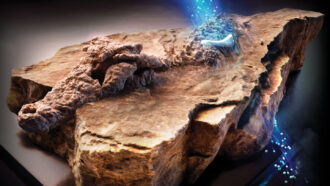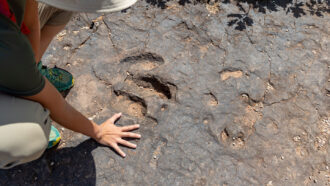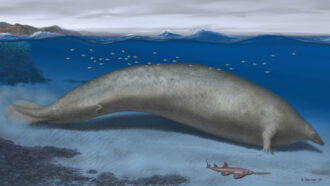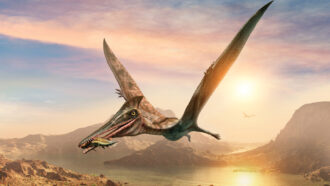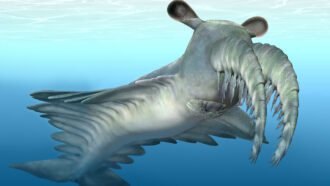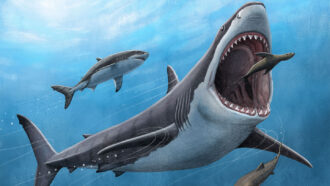This ancient reptile’s last meal may have truly been a killer
Fossils show the reptile died shortly after eating prey that was nearly as long as itself
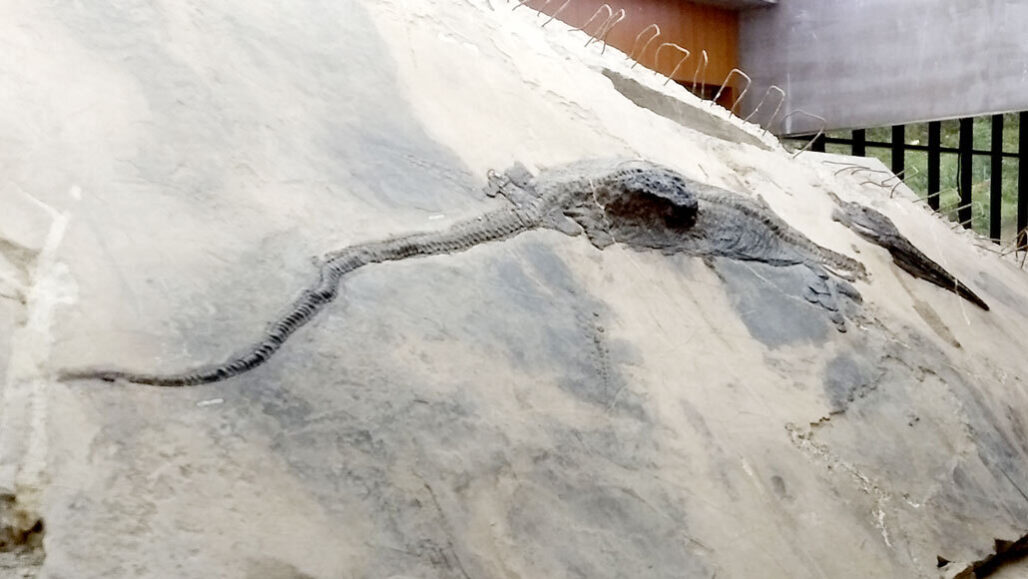
A bulge in the belly of a fossilized ichthyosaur (pictured) contains the remains of a reptile called a thalattosaur. That prey was nearly as long as the ichthyosaur itself. Such a big meal may have killed the predator, scientists say.
Ryosuke Motani
For its last meal, an ancient marine reptile may have bitten off more than it could chew. And that may have proved a lethal mistake.
Called an ichthyosaur (IK-thee-oh-sore), the dolphinlike predator was nearly 5 meters (16 feet) long. That’s about the length of a canoe. In its belly were the remains of a lizardlike reptile called a thalattosaur. At 4 meters (13 feet), this prey was almost as long as the predator. This is the longest known prey of a marine reptile from the dinosaur age. In fact, this particular thalattosaur may have been such a big meal that the ichthyosaur died after eating it.
The predator’s blunt teeth suggest it should have favored small, soft prey, such as ancient kin of octopuses and squid. “Now we have really solid evidence saying these [blunt] teeth can be used to eat something big,” says Ryosuke Motani. He is a paleobiologist at the University of California, Davis. He says that means the other species with similar teeth may be megapredators, too.
Motani was part of a team that examined the nearly complete skeleton of an adult ichthyosaur. It was unearthed in southwestern China in 2010. This reptile had lived during the Triassic Period, some 240 million years ago. Upon closer look at a big lump of bones in the creature’s belly, the team discovered the ichthyosaur’s last meal. It was the body of a thalattosaur. But not a whole one. It was missing both its head and tail. Stomach acid had not degraded the lump of bones. That hints the ichthyosaur died shortly after its meal.
The team reported its findings August 20 in iScience.

Educators and Parents, Sign Up for The Cheat Sheet
Weekly updates to help you use Science News Explores in the learning environment
Thank you for signing up!
There was a problem signing you up.
This meal was so big!
These fossils provide “pretty good evidence that the bigger animal ate the smaller one,” says Steve Brusatte. He is a vertebrate paleontologist in Scotland at the University of Edinburgh. “If this really is the case, it’s quite stunning,” he says. The predator was not much longer than its prey, although it was roughly seven times as massive.
The researchers believe the ichthyosaur most likely hunted its meal. It would have been unusual to come across a whole dead animal that no other predator had gobbled up. And the ichthyosaur would have had to shovel down the huge meal on the seafloor. That’s a tough task for an air-breathing creature.
The thalattosaur’s limbs also were still at least partially attached to its body. Its tail? That turned up about 20 meters (65 feet) away. If the thalattosaur was a carcass when the ichthyosaur found it, the prey’s limbs would have rotted off before its tail did, the team argues.

Motani suspects that killing and eating the thalattosaur may have spelled the predator’s end as well. The predator’s fossilized body and head are detached from one another. That suggests the bigger animal died of a broken neck. This ichthyosaur might have injured its neck while thrashing its head as it held the thalattosaur in its jaws. That is how crocodiles and killer whales rip up their food. Like this predator, they also have blunt teeth.
The ichthyosaur also could have hurt itself while swallowing its big prey. “This is not a snake that’s adapted to swallow something really big,” Motani says. “It had to swallow just like dolphins and crocodiles do.” That means it would swim against its prey to shove the food down its throat. Or it could have stuck its head above water and used gravity to gulp the meal down. Concludes Motani: “It could easily damage its neck doing this.”


